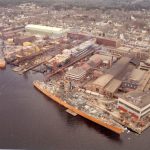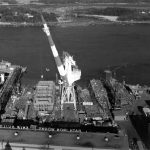In the late 1960s, the Navy adopted a new approach for the DX Program, a large class of destroyers meant to replace aging WWII-era ships in the fleet. Rather than preparing an initial design and seeking bids to build a few ships each year, the Navy planned to award a single contract for design and construction of up to 85 ships. The winner-take-all DX competition would be worth billions of dollars, and attracted interest from the largest aerospace and defense companies.
Faced with this stiff competition and few options for other work, BIW submitted its proposal for the DX program in 1969. The proposal included a vast expansion of the shipyard south along the river, nearly to today’s Maine Maritime Museum property. Despite BIW’s best efforts, the yard was significantly outbid, and the DX program was awarded to a competitor. This left the company’s future in doubt, as by 1970 there were no ships under construction in Bath, and little prospect of future Navy shipbuilding work.
Hope for BIW’s survival lay in two directions, both outside the yard’s normal work: commercial shipbuilding and Navy overhaul and repair work. BIW’s first postwar commercial contracts, for 610-foot Sea Witch-class container ships, came a few years before the DX contract loss. Three of these ships, hulls 354 through 356, were constructed in 1965-1969, alongside the last of the West German destroyers.
Following the DX contract loss, BIW pursued this commercial work more aggressively and received orders for three more of the class, built in 1970-1973. These were followed by four Sealift-class tankers and four Maine-class roll-on/roll-off car carriers, through the mid-1970s.
Alongside the commercial shipbuilding program, BIW successfully pursued Navy overhaul work. Starting in the late 1960s and running into the 1980s, BIW did overhaul and modernization work on more than 40 Navy and Coast Guard ships. While most were destroyer-type ships, including some built at BIW just a few years earlier, the 796-foot replenishment tanker USS Detroit set a record as the largest ship ever seen on the Kennebec River. This business was valuable in filling gaps in the yard’s workload, but came to an end when the Navy decided to perform overhauls in the ships’ homeports, to minimize disruption for the crews.
Despite the challenging times, BIW invested heavily in shipyard modernization throughout the 1970s. This expansion allowed construction of much larger commercial ships and pre-outfitted ship units of up to 220 tons, a dramatic increase from 50-ton units in the 1950s. In this era, three of the old wooden shipways were rebuilt with concrete and steel, the fourth set of ways was replaced by the landmark 220-ton capacity #11 crane, and most of the old elevated craneways were removed. The yard modernization also included construction of the first modern blast and paint facilities, the first section of today’s Assembly Building, and pier #3 – originally a finger pier projecting into the river, but now the north face of the Land Level facility. This modernization left the yard well-positioned to win future business, both commercial and naval.




